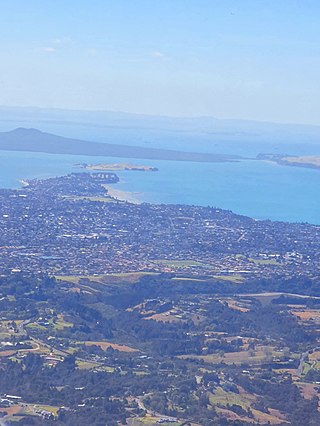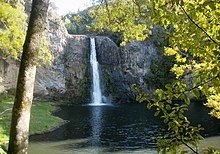
The Hunua Ranges is a mountain range and regional park to the southeast of Auckland city, in the Auckland and Waikato regions of New Zealand's North Island. The ranges cover some 250 square kilometres (97 sq mi) and rise to 688 metres (2255 ft) at Kohukohunui.

Clevedon, previously known as Wairoa South, is a rural town to the south-east of Auckland, New Zealand, in the local government area of Franklin. The area is part of the rohe of Ngāi Tai ki Tāmaki, who settled around the Wairoa River. The original township was founded in the 1850s, and was named Clevedon in 1866. Over time, it has developed into a centre for the dairy industry south-east of Auckland.

Pakuranga is an eastern suburb of Auckland, in northern New Zealand. Pakuranga covers a series of low ridges and previously swampy flats, now drained, that lie between the Pakuranga Creek and Tamaki River, two estuarial arms of the Hauraki Gulf. It is located to the north of Manukau and 15 kilometres southeast of the Auckland CBD.

Bucklands Beach is a suburb 13 kilometres (8.1 mi) east of Auckland's CBD in New Zealand. The suburb is in the Howick ward, one of the thirteen administrative divisions of Auckland Council.

Beachlands is an outer suburb of Auckland, New Zealand, established in the 1920s, where development increased in the 1950s due to its popularity as a beach holiday destination. It is located on the Pōhutukawa Coast and in close proximity to Maraetai.

East Auckland is one of the major geographical regions of Auckland, the largest city in New Zealand. Settled in the 14th century, the area is part of the traditional lands of Ngāi Tai ki Tāmaki. The area was developed into farmland in the 1840s, and the town of Howick was established as a defensive outpost by fencibles to protect Auckland. Coastal holiday communities developed in the area from the 1910s, and from the 1950s underwent major redevelopment into a suburban area of greater Auckland. From the 1980s, the area saw significant Asian New Zealander migrant communities develop.

Ngāi Tai ki Tāmaki is a Māori tribe that is based in the area around Clevedon, part of the Auckland region. It is one of the twelve members of the Hauraki Collective of tribes.

Maraetai is a coastal town to the east of Auckland in New Zealand, on the Pōhutukawa Coast. Part of the traditional rohe of Ngāi Tai Ki Tāmaki, the area developed into a coastal holiday community in the early 20th Century.

Half Moon Bay, is a suburb of East Auckland, New Zealand, lying immediately south of Bucklands Beach. It is home to the Half Moon Bay Marina, where over 500 boats berth. It is located on the Tāmaki River in the Hauraki Gulf.

Duder Regional Park is a regional park situated on the coast to the east of Auckland, New Zealand, on the Whakakaiwhara Peninsula.

Ōtara is a suburb of South Auckland, New Zealand, situated 18 kilometres to the southeast of the Auckland City Centre. Ōtara lies near the head of the Tamaki River. The area is traditionally part of the rohe of Ngāi Tai ki Tāmaki, and the name Ōtara refers to Ōtara Hill / Te Puke ō Tara, a former Ngāi Tai ki Tāmaki pā and volcanic hill to the north of the suburb. From 1851 to 1910 the area was part of the Goodfellow family farm, and during the 1910s the area was an agricultural college run by the Dilworth Trust.

Highbrook is a suburb located in the city of Auckland, in the North Island of New Zealand. The area is on the eastern side of the Auckland city centre and is a large industrial area developed only in recent years. The area is under governance of the Auckland Council, and is home to a large bulk of New Zealand and international businesses and organisations.

Sunnyhills is a suburb of East Auckland, New Zealand, located on the eastern banks of the Tāmaki River near Pakuranga. Previously farmland within the Pakuranga Town District, suburban housing developed in the area in the mid-1960s.

Golflands is an eastern suburb of the city of Auckland, New Zealand. The Pakuranga Golf Club is part of the suburb, and many of the streets have names related to golf or notable golf players, such as Bob Charles drive.

The Ōtara Creek, is a major stream in South Auckland, in the Auckland Region of New Zealand's North Island. It flows northwards, then westwards into the Tāmaki River.

Magazine Bay is a bay in the Auckland Region of New Zealand's North Island. It is located to the east of Maraetai.

The Pōhutukawa Coast is an area of the Auckland Region in New Zealand. The area covers townships south of the Tāmaki Strait: Whitford, Beachlands, Maraetai and Umupuia. The area was traditionally known as Maraetai, and is within the rohe of Ngāi Tai ki Tāmaki. In the 1920s, seasonal holiday communities developed in the area, which became permanent residential towns by the 1950s.

Tūranga Creek, also known as the Tūranga River or Tūranga Estuary, is a stream and tidal estuary in the Auckland Region of New Zealand's North Island. The township of Whitford was founded at the navigable headlands of the creek.

Pakuranga Creek is a tidal estuary and stream in the Auckland Region of New Zealand's North Island. The creek flows from inlant Pakuranga, meeting the Pakuranga Stream and flows into the Tāmaki River.

Tara Te Irirangi (1780s–1852) also known as Te Tara ki Moehau or Ōtara Te Irirangi, was paramount chief of Ngāi Tai ki Tāmaki or Ngāti Tai, a Māori tribe of the eastern Auckland region of New Zealand, encompassing parts of the Hauraki Gulf and Wairoa Valley, as well as Ōtara, Clevedon, Maraetai and Howick. Te Irirangi was the great-grandson of Te Wana, a leading rangatira and well-known warrior of Ngāi Tai, who, during his life, strengthened Ngāi Tai control over the Maraetai-Wairoa area. Tara Te Irirangi died in 1852, after falling ill, and passed away at the mouth of the Wairoa River. He was interred in his waka in the Ngāi Tai burial swamps within the west bank of the river.























